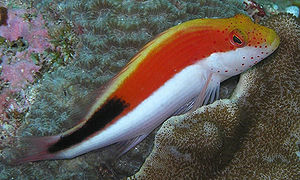Striped coral guardian
| Striped coral guardian | ||||||||||||
|---|---|---|---|---|---|---|---|---|---|---|---|---|

Striped coral guardian ( Paracirrhites forsteri ) |
||||||||||||
| Systematics | ||||||||||||
|
||||||||||||
| Scientific name | ||||||||||||
| Paracirrhites forsteri | ||||||||||||
| (Schneider in Bloch & Schneider , 1801) |
The striped coral guardian or Forster's tufted perch ( Paracirrhites forsteri ) is a tropical fish of the group of tufted perch (Cirrhitidae) and thus belongs to the perch relatives (Percomorphaceae).
features
Striped coral guardians have a typical perch shape with a relatively large head. Their coloring is very variable. The basic color is usually white, yellowish or red. The topline is pale gray to yellowish, in the upper third of the flanks a dark brown to black longitudinal bar extends from the head to the tail fin base, which is sometimes only pronounced in the rear third of the body. The cheeks are red, brown, gray or white and red or black spotted. They become 18 to 22 cm long.
Occurrence
Striped coral guardians, like most of the species in his family, occur over coral banks in the tropical Indo-Pacific , in the Red Sea and off the coasts of Hawaii . They can also be found off the west and east coast of Australia and the islands in front of them.
nutrition
Striped coral guardians linger over corals on their thickened pectoral fin rays and wait for prey, mostly fish and crustaceans, to swim by .
Aquaristics
For keeping the Striped Coral Guardian in an aquarium , a tank of at least 400 liters of water, which should be kept at a temperature between 24 and 26 ° C, is required. Artemia , Mysis , shrimp , live food and coarse types of frozen food are commercially available for nutrition . The Striped Coral Guardians are undemanding and easy to keep, but they are rarely offered in stores. Since they eat small fish and shrimps in nature, they should not be brought with potential prey, e.g. B. socialize small damselfish of the genus Chromis .